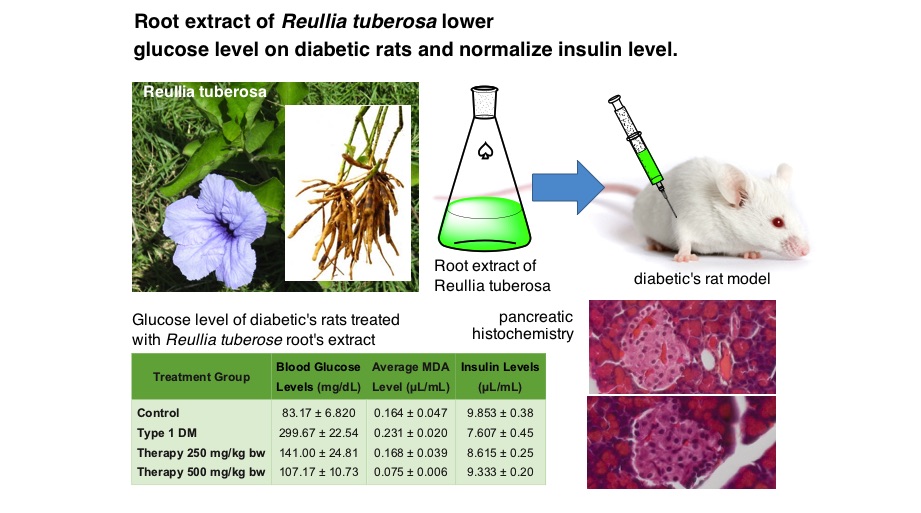Effects of Ruellia tuberosa L. Root Extract on the Pancreatics of Diabetic Rat
Abstract

Diabetes mellitus type 1 (DMT1) is an insulin deficiency disorder caused by pancreatic damage characterized by chronic hyperglycemia. Animal modeling of DMT1 using inducting Multiple Low Dose Streptozotocin (MLD-STZ) elevat levels of free radicals and inflammation in pancreatic organs which then damage β cells. Ruellia tuberosa L. is a plant containing triterpenoids from the class of antioxidant and anti-inflammatory flavonoids. This study used three groups of rat: negative control group, positive control and 240 mg/kg bw therapy group. Study are based on changes MDA levels, blood glucose and histologic of pancreas. MDA level determining with TBA method, glucose levels using EasyTouch GCU and histopalogy of pancreas using Hematoxylin-Eosin staining. Statistical analysis of MDA and blood glucose (α = 0.05) showed significant decreases in MDA and blood glucose levels. Based on the results of histologic observations of pancreas descriptively showed a decreas in cell damage on Langerhans island. Thus, the provision of root extract of Ruellia tuberosa L. can inhibit the damage in rat DMT1 model so that it can be used as therapy of diabetes mellitus.
References
[1] M. M. Tibrani, Kadar Insulin Plasma Mencit yang Dikondisikan Diabetes Mellitus Setelah Pemberian Ekstrak Air Daun Nimba, Seminar Nasional Penelitian, Pendidikan, dan Penerapan MIPA, 2009, pp. 112–120. website
[2] E. K. A. Denik and I. Fuspita, Distribusi Sel Insulin Pankreas Pada Tikus Hiperglikemia yang Diberi Diet Tempe, Skripsi, 2009, pp. 17–54.crossref
[3] D. Cavan, J. da Rocha Fernandes, L. Makaroff, K. Ogurtsova, and S. Webber, IDF Diabetes Atlas, International Diabetes Federation, Brussels, Belgium, 7th edition, 2015.
[4] Kementrian Kesehatan Republik Indonesia, INFO DATIN, http://www.depkes.go.id/folder/view/01/structure-publikasi-pusdatin-info-datin.html., pp. 1–8, 2015.
[5] R. P. Robertson, J. Harmon, P. O. Tran, Y. Tanaka, and H. Takahashi, Diabetes, 2003, 52, 581–587.crossref
[6] Mahardhian, M. A., A. Aulanni'am, and C. Mahdi, J. Pure App. Chem. Res., 2013, 2(2), 72–78. crossref
[7] Gina, L. P., A. Aulanni'am, and C. Mahdi, J. Pure App. Chem. Res, 2016, 5(1), 40–47. crossref
[8] M. Kurniawati, C. Mahdi, and A. Aulanni'am, J. Pure App. Chem. Res., 2014, 3(1), 1–6. p. Chem. Res., 2013, 2(2), 72–78. crossref
[9] V. R. Mohan, Rajendra K. N, Vasantha K., AJPCT. , 2014, 2(2), 209–216. website
[10] K. P. A. M. K. Luxmini, R. M. Dharmadasa, and K. P. R. M. Muthukumarana, World J Agric Res, 2015, 3(1), 28–33.crossref
[11] C. Lin, Y. Huang, L. Cheng, S. Sheu, and C. Chen, Natl. Res. Inst. Chinese Med., 2006, 17(3), 103–109. website
[12] D. L. Chothani, M. B. Patel, S. H. Mishra, and H. U. Vaghasiya, Phcog J., 2010, 2(12), 506–512. website
[13] Manikandan, D. V. A. Doss, and T. Nadu, J. Chem. Pharm. Res., 2010, 2(3), 295–303. crossref
[14] X. Yang, Q. Wang, Z. R. Pang, M. R. Pan, and W. Zhang, Pharm. Biol., 2017, 55(1), 1207–1214,. crossref
[15] M. N. Samy, S. Sugimoto, K. Matsunami, H. Otsuka, and M. S. Kamel, Int J Pharmacogn, , 2015, 2(6), 270–279. website
[16] Jurenka, J. S., Altern Med Rev., 2009, 14(2), 141–153. website
Refbacks
- There are currently no refbacks.

This work is licensed under a Creative Commons Attribution-NonCommercial 4.0 International License.








